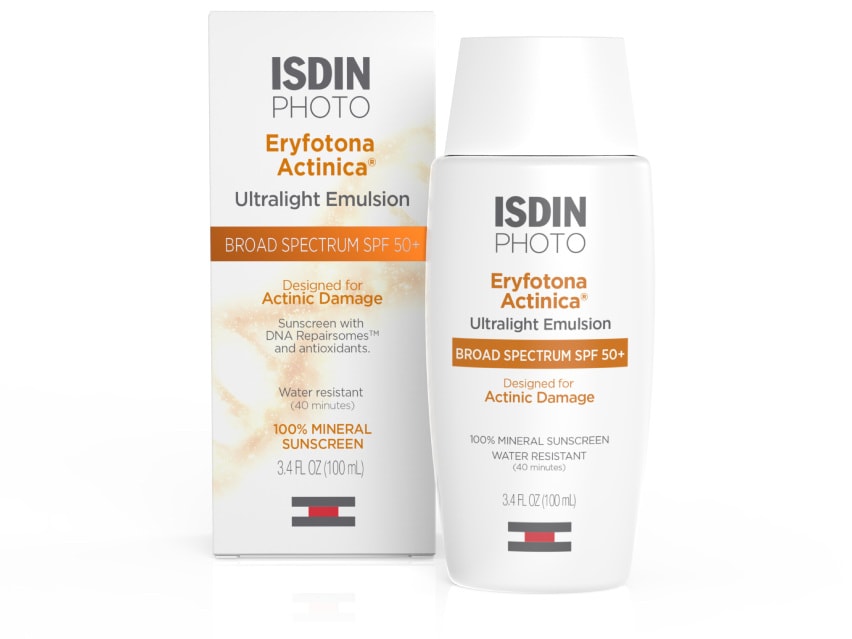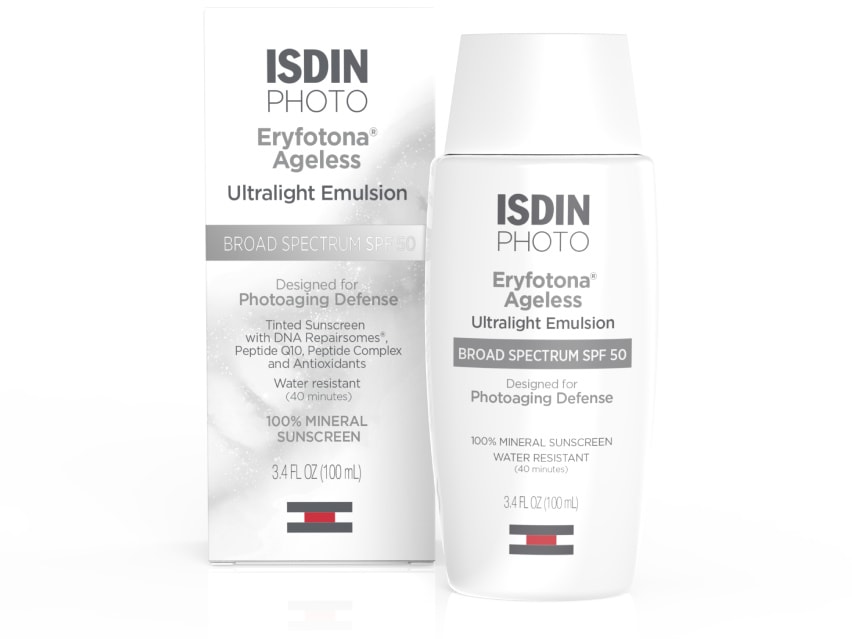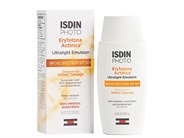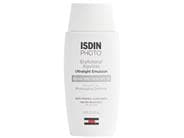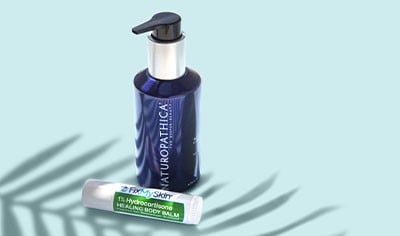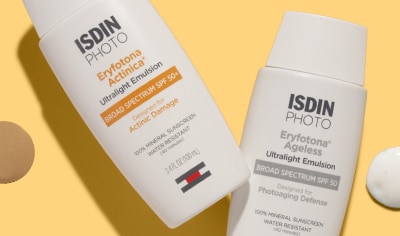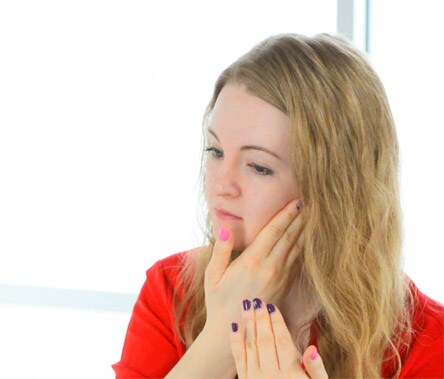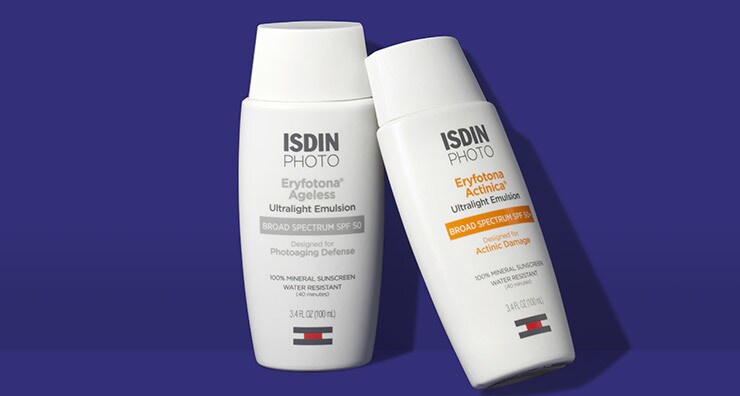
The experts from ISDIN are here to share the latest info about skin health.
Though it can be unsettling to think about, skin cancer is the most common cancer in the United States, so knowing the facts is important. In honor of Melanoma Awareness Month this May, we aim to shed light on a subject that affects so many lives each year. With the help of board-certified dermatologist and LovelySkin CEO Dr. Joel Schlessinger and the American Academy of Dermatology, we’ve gathered five melanoma facts and statistics you should know about, including:
Melanoma awareness fact #1: It can affect anyone, regardless of skin color
Melanoma can affect all of us. While people with lighter skin tones are more likely to develop melanoma, people with skin of color often go undiagnosed for longer periods of time. This aggressive cancer is also harder to treat in later stages. On top of that, people with melanin-rich skin tones are susceptible to skin cancer in areas that aren’t always exposed to the sun: palms of the hands, the soles of the feet, the groin and the inside of the mouth. Under the nails is another vulnerable spot. For this reason, the American Academy of Dermatology encourages people of all skin tones to perform self-exams and do their best to visit a dermatologist at least once a year.
Melanoma awareness fact #2: It’s the most life-threatening form of skin cancer
With early detection, melanoma is very treatable. It’s also much less common than many other types of skin cancers. However, it’s the most dangerous, as it’s more likely to spread to other areas if left untreated. While melanoma can spread to the lymph nodes and later to other organs, the likelihood of this depends on the type of cancer. There are four main types of melanoma:
Superficial spreading melanoma: This is the most common type, making up around 70% of all melanomas. They tend to grow across the skin surface and are often flat in appearance with an uneven border and varying colors. They commonly appear on the torso, arms and legs. “Most people don’t realize that the dark, flat moles are usually the most dangerous,” Dr. Schlessinger says.
Nodular melanoma: This type of melanoma makes up almost 20% of all melanomas and spreads more rapidly than other types. It typically presents as a black, red or pink raised growth. Nodular melanoma usually develops on the face, chest, back or areas not usually exposed to the sun.
Lentigo maligna melanoma: Mostly developing on areas of skin that are regularly exposed to the sun without protection, lentigo maligna melanomas commonly appear on the face, ears, and arms. They are typically flat, darken over time and are relatively slow-spreading.
Acral lentiginous melanoma: This is most common in people with skin of color. Unrelated to sun exposure, this type of melanoma makes up under 5% of all types. They usually develop on the soles of the feet, palms of the hands or under the nails.
The good news? You’re already taking the first step in protecting yourself by gathering information and raising awareness.
Melanoma awareness fact #3: Around half of melanomas are self-detected
Because about half of melanomas are self-detected, you can potentially play a big role in the fight against melanoma. While self-exams can’t diagnose melanoma or replace a yearly visit to a board-certified dermatologist, they can help you be proactive. Start by keeping track of any new moles or areas of color change on the skin, noting any shift in size, shape or color. The American Academy of Dermatology suggests following the ABCDE technique for regular self-exams at home:
Asymmetry: The outline of one half of the mole is different from the other.
Borders: The edges are uneven, ill-defined or irregular.
Color: The color is uneven and can include black, brown and cinnamon-colored shades. “This is the most important of all features, bar none,” Dr. Schlessinger says.
Diameter: Its size changes, usually increasing in size.
Evolution: Any changes in the mole in the last few weeks or months.
If you notice any of the changes above, it’s best to get in touch with a board-certified dermatologist for a professional exam. “If you have family history of skin cancer, I also recommend visiting a board-certified dermatologist for a skin check at some point,” Dr. Schlessinger says. “Your dermatologist will determine the cadence of your need for visits once they evaluate you. Generally, once every year is best for high-risk individuals—those with a strong family history of skin cancer or, especially, melanoma.”
Melanoma awareness fact #4: Most cases are attributed to UV exposure
Before we talk about what causes melanoma, let’s talk about what it actually is. Melanocytes are the cells in your skin that give your skin its color. Melanoma is a type of skin cancer that occurs when melanocytes start to reproduce uncontrollably. Repeated, unprotected sun exposure can increase the chances of this happening.
Too much UV radiation from the sun can cause the appearance of lesions on the skin, and these lesions can be precancerous or cancerous. Within this group of cancerous lesions lies melanoma. “Tanning beds are another cause of melanoma,” Dr. Schlessinger says. “Research has shown that if you used tanning beds before the age of 20, your risk of melanoma is increased by 47%. In addition to the increased risk of melanoma, wrinkles and sun damage are a sad consequence of tanning bed usage, but they don’t usually occur until about ten to twenty years later.”
Melanoma awareness fact #5: Proper sun protection can help minimize your risk
Not all melanomas can be prevented—some cases are related to genetics or immunosuppression—but you can take steps to reduce your risk of all types of skin cancer, including melanoma. Here’s what you can do to help protect yourself:
Avoid direct sun exposure and seek shade during midday hours, when solar radiation is stronger. Remember, the smaller your shadow is, the stronger the sun.
Avoid sunburn and always use sunscreen on exposed skin. For proper protection, use a high-SPF broad-spectrum sunscreen, such as ISDIN Eryfotona Actinica Daily Lightweight Mineral SPF 50+ Sunscreen. Apply it generously about fifteen minutes before exposure and reapply at least every two hours.
Wear protective clothing when in the sun. Turn to sunglasses, umbrellas, hats and clothing.
Now that you know more melanoma and skin cancer facts, we hope you feel more empowered to protect yourself. Remember to use a broad-spectrum sunscreen, such as ISDIN Eryfotona Ageless Ultralight Tinted Mineral SPF 50 Sunscreen, daily and examine your skin regularly at home and with your dermatologist.
You can learn more about ISDIN’s broad-spectrum sunscreens and other skin care products on the LovelySkin Blog.
Shop this blog

About the Author
Amy is a content strategist who turned a part-time obsession with skin care into a full-time passion. Her experience as a creative storyteller includes a range of lifestyle and technology topics across Washington D.C. and Barcelona. What's in her travel bag? Eye contour cream and sunscreen, always.
Other Posts by Amy IngrahamMeet vitamin C’s skin care sidekicks
Your 5-step dermatologist-approved morni...
Follow us on social
Follow us on social networks and be one of the first to learn about sales, giveaways, and free samples

